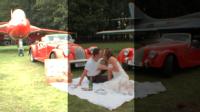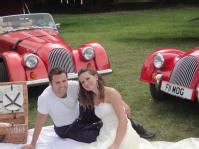Morgan car lovers 1st to benefit from High Dynamic Range TV's arrival on domestic TV

 HDR video captures a wider range of light intensity levels found in real scenes ranging from direct sunlight to lowlight images and thanks to a partnership between Researchers at WMG, University of Warwick, goHDR Ltd. and Altera® Toronto Technology Center the technology has now been developed to create an embedded system that can be connected to existing domestic televisions, allowing them to display High Dynamic Range (HDR) content.
HDR video captures a wider range of light intensity levels found in real scenes ranging from direct sunlight to lowlight images and thanks to a partnership between Researchers at WMG, University of Warwick, goHDR Ltd. and Altera® Toronto Technology Center the technology has now been developed to create an embedded system that can be connected to existing domestic televisions, allowing them to display High Dynamic Range (HDR) content.
The partners are to give the first public demonstration of HDR-enabled television working with a standard LED TV at the IBC 2011 event in Amsterdam (hall 8, stand 8.G41 from 9-13 September). Here they will show the technology using a specially created short film called ‘Morgan Lovers’ which was shot, manipulated, and can be displayed entirely in HDR. This was a collaborative venture with local film maker, Vermillion Films, and Morgan Cars and was brought about through WMG’s International Digital Laboratory’s SME programme which is funded by Advantage West Midlands.
 HDR video captures a wider range of light intensity levels found in real scenes ranging from direct sunlight to lowlight images. HDR imagery offers a significantly enhanced viewing experience even when the higher contrasts are reduced (through appropriate luminance compression algorithms, known as tone mapping) for display on Low Dynamic Range (LDR) devices, such as on computer monitors or televisions. This enhanced experience allows the viewer, for example, to clearly see the details of a racing car when it enters or leaves the tunnel, or vastly reduce a passing cloud’s disruption of the view of the action on a football pitch. Furthermore, the increased lighting of HDR content provides better depth perception, allowing a 3D viewing experience without the need to wear special glasses.
HDR video captures a wider range of light intensity levels found in real scenes ranging from direct sunlight to lowlight images. HDR imagery offers a significantly enhanced viewing experience even when the higher contrasts are reduced (through appropriate luminance compression algorithms, known as tone mapping) for display on Low Dynamic Range (LDR) devices, such as on computer monitors or televisions. This enhanced experience allows the viewer, for example, to clearly see the details of a racing car when it enters or leaves the tunnel, or vastly reduce a passing cloud’s disruption of the view of the action on a football pitch. Furthermore, the increased lighting of HDR content provides better depth perception, allowing a 3D viewing experience without the need to wear special glasses.
WMG’s Professor Alan Chalmers said:
“This project has brought together worldwide expertise in HDR imaging from the University of Warwick with the innovation and in-depth market knowledge of goHDR and Altera. Together the partners have demonstrated the technical and commercial viability of HDR-enabled television.”
“HDR video has very large data and computational requirements. This creates significant challenges for video processing on a low power embedded platform such as a television or set-top box. Our project comprises a highly novel system in which compressed HDR video content is carefully streamed from goHDR’s compression algorithm to an Altera Field Programmable Gate Array (FPGA) which exploits massive amounts of parallelism to achieve high processing rates at a fraction of the power required by other solutions. The goHDR’s compression is specifically designed for HDR video and is able to achieve at least 100:1 compression with minimal perceptual loss.
This project brings together worldwide expertise in HDR imaging and a unique HDR video technology from:
- International Digital Laboratory, WMG, University of Warwick: www.digital.warwick.ac.uk
- with a new high-tech company specialising in HDR technology, goHDR: www.gohdr.com
- and highly innovative research at Altera which is targeting software developers who wish to execute their applications on FPGAs: www.altera.com
The short film, “Morgan Lovers”, shot and delivered entirely in HDR was a collaboration between:
- International Digital Laboratory, WMG, University of Warwick: www.digital.warwick.ac.uk
- Advantage West Midlands: http://www.advantagewm.co.uk/
- goHDR Ltd: http://www.gohdr.com/
- Vermillion Films: www.vermillionfilms.com
- Morgan Cars: www.morgan-motor.co.uk
- Vintage Flyers, Cotswold Airport: www.vintage-flyers.com
- The Boultbee Flight Academy: www.boultbeeflightacadamy.co.uk
The partners will be showcasing the HDR-enabled TV at the IBC 2011 event in Amsterdam (hall 8, stand 8.G41) from 9-13 September. Started in 1967, IBC is now one of the premier annual events for broadcast professionals. Last year it attracted over 48,000 people from 140 countries.
About The International Digital Laboratory
The Digital Lab, WMG, University of Warwick is a £50 Million state-of-the-art capability designed to facilitate major collaborative research opportunities, create effective knowledge transfer between academia and industry and generate new knowledge and skills with an impact on business, society and the economy.
About WMG
WMG was founded by Professor Lord Kumar Bhattacharyya in 1980 in order to reinvigorate UK manufacturing. The Group started small: just an office, the Professor and his secretary. Today there are over 450 staff working across four buildings at Warwick, with education centres in six countries and an annual programme of over £120m. The Group works with both global companies and regional SMEs to improve their competitiveness through the application of value-adding innovation, new technologies and skills deployment, bringing academic rigour to industrial and organisational practice. The research capabilities span three themes: digital technologies, materials & manufacturing, and operations & business management.
For further information please contact:
Professor Alan Chalmers, WMG, University of Warwick
Tel: +44 (0)782 454 0960 Alan.Chalmers@warwick.ac.uk
Peter Dunn, Head of Communications, University of Warwick
Tel: +44 (0)24 76 523708 or mobile +44 (0)7767 655860 p.j.dunn@warwick.ac.uk
PR126 7th September 2011
